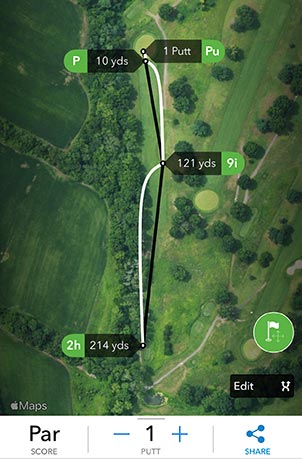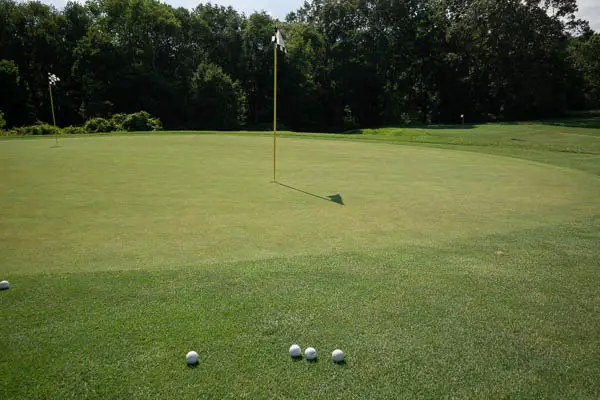Everyone starts somewhere.
Even Tiger Woods had to break 100 for the first time once. Of course, he probably did it around the same age that most of us are taking the training wheels off our bikes, but you get my point.
Getting your score down to a legitimate two digit score is something to be proud of and something a lot of recreational golfers never do.
But often, golfers fail because they make it way harder on themselves than it has to be. So I’m going to share with you 11 tips to help you break 100 in golf.
1. Play For Bogeys (Forget About Par)
Par is just an arbitrary number and worrying about making par can easily turn a 95 into a 115 score.
Instead of playing for par on each hole, your goal should be to shoot bogey.
If you get a bogey on every hole, that’s a 90 on most courses! So that gives you a full 9 stroke margin of error.
As a higher handicap golfer, focusing on making par is both unlikely and can lead you to make bad decisions or attempt shots that are beyond your skill. The result can often be double and triple bogeys instead of bogeys, which are what you need to avoid if you want to break 100.
We’ll talk a little more about some course management strategy below.
2. Keep The Ball In Play
Penalties for a lost ball, water hazard, or out of bounds are going to blow up your score quickly. As a golfer trying to break 100, avoiding these should be a very high priority.
It can be enticing to take out the driver on every hole, but that’s also the club that is often the most likely to be hit offline and result in one of these kinds of penalties. I’m not saying to leave the driver at home (although that may benefit a lot of you). Golf should be fun and part of that is taking a big swipe with the one wood.
But save it for the wide open holes with no trouble. That way you can get used to hitting it on the course and still stay out out trouble.
When you do have shots with hazards in play, forget about aiming for the pin (or maybe even the green) and instead just think about playing away from the hazards. You’ll be much better off having to chip the ball from off the green than you would if you hit it in the water.
Aiming away from hazards should become a big part of your course management. And speaking of course management…

3. Use Some Simple Course Management
Golfers at this level are so focused on hitting the ball well that they don’t really think about managing their way around the course.
Even when you’re shooting in the hundreds, you should be thinking about the hole from the green back. Here’s how you do that.
- Identify a spot short of the green that you feel gives you a good change to hit the green.
- Now think about where you need to get the ball to let you hit the spot you chose in #1.
- Keep working your way back to the tee like this.
Remember, your goal is to make bogey. That means that you can take two shots to get to a par 3 green, three shots to get to a par 4 green, and four shots to get to a par 5 green.
Knowing you can take these extra shots to get to the green will let you break the hole down into shorter shots. That increases your probability of successfully executing the shots and reduces the probability of making a big score.
4. Forget About Distance
Hitting the ball far and swinging fast should be the last thing on your mind. Instead, your goal on every shot is to make solid contact with the center of the club on the ball.
After watching Dustin Johnson and Bryson DeChambeau punish glf balls 350 yards down the fairway, you might think that you need to hit the ball as far as possible to lower your scores.
That works for pros but not for you.
First off, their goal is to get as many birdies as possible (and they have the skills to do it). So monster drives work for them. Your goal is keeping the ball in play and making bogeys. So modeling your strategy after the best pros in the world is not going to work out well for you.
Remember, you need to work your way back from the hole and position yourself safely. Hitting as far as you can is going to result in every other shot ending up off the map somewhere.

Second, you’re not playing on PGA Tour courses. Your local course is a lot shorter than those and it takes a lot less distance to score well. There are plenty of scratch golfers that hit their drives under 250 yards.
And on the subject of course difference, let’s talk about the tees you play from…
5. Play The Right Tees
The whole naming system of Men’s, Women’s, Senior’s, and Pro/Championship tees was a bad idea when it started and it is slowly becoming obsolete.
So forget about whatever name they give the tees. It’s arbitrary and has nothing to do with age or gender.
There are several ways I have seen published out there to determine which tees to play. The PGA of America has put out this chart.
| Average Drive | Recommended Tees |
|---|---|
| 100 yards | 2,100 – 2,300 yards |
| 125 yards | 2,800 – 3,000 yards |
| 150 yards | 3,500 – 3,700 yards |
| 175 yards | 4,400 – 4,600 yards |
| 200 yards | 5,200 – 5,400 yards |
| 225 yards | 5,800 – 6,000 yards |
| 250 yards | 6,200 – 6,400 yards |
| 275 yards | 6,700 – 6,900 yards |
| 300 yards | 7,150+ yards |
These aren’t necessarily bad recommendations, but they only work if you are honest about how far you hit on average while keeping the ball in play most of the time. If you hit that one drive downhill, downwind, on a dry fairway that went 290 yards…that’s not your average.
If you want a reality check on your distances, check out this shot tracker I reviewed.
But playing the right yardage has a lot more to do with consistently making good shots than just hitting it far.
My recommendation is that those of you trying to break 100 should be playing the tees that are at most 5,500 yards. And if you’re a shorter hitter then adjust down accordingly.
6. Play Your Shot Shape
Most high handicappers tend to slice the ball.
That’s ok, a little later on we’ll talk about improving your swing, but for now let’s assume you’re headed to the course tomorrow and want to score as well as possible.
Don’t fight your tendencies when you’re on the course.
If you slice the ball, aim left and let it slice and vice versa if you hook it. If you tend to top the ball and hit grounders, then don’t try to carry the ball over water unless absolutely necessary.
Working your way around the course is all about understanding your skills and planning accordingly. Let your brain, not your ego, plan out your shots.
7. Learn The Rules
You might get mad at penalty shots or having to play the ball out of a divot when you do hit the fairway, but the rules can be your friend too.
There are a number of situations where you get a free drop that can make your next shot easier and knowing all of your options when you take a drop from a water hazard can save a stroke or two on occasion.
There’s far too many helpful rules in golf to cover them all here, but if you plan on playing this sport for any extended period of time, pick up a rule book and give it a read.
8. Play The Right Equipment
There are clubs for every type of player and playing the right clubs for you can make a major difference in how well you score and how much you enjoy the game.
First off, as someone trying to break 100, forget about playing the same exact model clubs as your favorite tour pro. Those clubs aren’t for you and chances are the tour pro has his custom made in a way that you couldn’t get if you wanted.
Look for clubs that are forgiving, prevent mishits from becoming disasters, and help you get the ball up in the air on a nice trajectory.
Luckily, we did a lot of the work for you identifying the best of these kinds of clubs in some of our buying guides.
- Best Drivers For High Handicappers
- Best Fairway Woods For High Handicappers
- Best Hybrids For High Handicappers
- Best Irons For High Handicappers
9. Get Comfortable Around The Greens
You’re going to miss the green often. But that’s ok.
Being comfortable with short chips and pitches around the green is an essential part of lowering your score. Short game skills won’t help much if you take 8 shots to get near the green, but you also don’t want to take a lot of shots when you’re so close to the hole.
Work on developing a simple chip shot first. Think of it like a putt with your wedge. Keep your weight on the foot closer to the hole and just focus on making solid contact. Once you can do that consistently, getting the feel for distance will come with repetition.
And don’t forget putting. Putting is the easiest part of the game to become reasonably proficient at. Your goal should be to take two puts to get the ball in the hole from anywhere on the green.
For far putts, focus on getting it to stop close. On closer putts, you’re trying to make the putt. But above all, avoiding three-putts on one green should be considered a success.

10. Take Some Lessons
This last one might be obvious, but the more you can work on your game and improve your skill, the easier it will be to break 100.
But lessons are also important at this stage to prevent you from developing bad habits that could last a long time. I still have habits that started when I was a beginner that tend to creep into my swing if I don’t stay on top of my swing mechanics.
So getting a professional to help you out from the beginning means that those initial habits you develop are going to be good one.
11. Don’t Get Down On Yourself
Golf can be a frustrating game.
Even the best players in the world get really frustrated. Although, sometimes that’s part of the fun of watching them (and they’re still making millions).
But frustration and losing confidence can affect how well you play. It causes you to lose focus and probably forget the most of what you just read here.
The best thing you can do is just remember that its a game that you play for fun and not your livelihood. Also, maybe don’t play for money if you haven’t broken 100 yet.
Now get out there and have some fun.



